Article contents
Extract
Mr. Stephens.—Before the paper is read, I wish to make a few observations on the discussion which ensued on the very interesting paper which was read at the last meeting, On that occasion Mr. Whomes challenged the audience, and I accepted the challenge, to name the key of every piece that he played, the pianoforte being concealed from us. I put down on paper, and read afterwards, the key of every piece which he played, as they appeared to me at least, and the Chairman, who had sat at the pianoforte, came afterwards to the table and read out the key in which he had seen Mr. Whomes play. In every case the key in which Mr. Whomes had played on the pianoforte was a semitone higher than the one I had named. Now I am very anxious that any impression should be removed that I had been guilty of a failure on that occasion. It was simply that Mr. Whomes had, for the special purpose of his lecture, caused the pianoforte to be tuned a semitone lower; consequently, I was right in every instance, and Mr. Whomes has kindly come here on this occasion to corroborate what I say, and acknowledge that, for the purpose of his lecture, he was obliged to practise what, applied to my own particular case, would appear a deception, and he will acknowledge, I believe, that I was right in every instance as regards the true pitch, and when a selection from a Concerto of Beethoven in C minor was played, I said, not in C minor, but in B minor, and so it proved. After several of the audience were gone away, we compared the pianoforte with another one in the room, and found it was exactly what I have said, half a tone below pitch; therefore, whatever the position may be with regard to tone colourists, I wish to claim that I was in every instance correct in my judgment as to the key which was played.
- Type
- Research Article
- Information
- Copyright
- Copyright © Royal Musical Association, 1886
- 1
- Cited by


